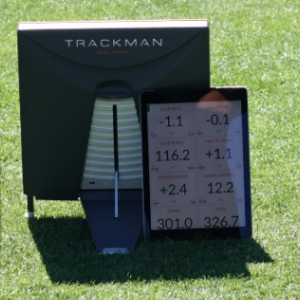
Charlie Hoffman with alignment rods
Spectators who attended the Dell Match Play Championship during the practice rounds on Monday and Tuesday spent more time watching players on the practice range, chipping and putting areas than they did on the course because there were no matches. And as any devoted golfer knows, you can learn a lot from watching how the best players approach their craft.
Aside from the obvious benefits of watching the players swing techniques and putting strokes, it is interesting to note their use of training aids.
Lets start with those you see on the driving range. The most obvious training device is the alignment rod. You see a lot of those on the range. Players use them to check the alignment of shoulders, hips and feet in relation to the target line as well as checking their ball position in the stance. This tool is ubiquitous, inexpensive and used by almost all low handicap players, whether they are professional or amateur.

Oosthuizen with alignment rod used to assist in his takeaway move.
Alignment rods or a variation of an alignment rod are also used for various purposes related to the players swing plane, shaft angle and take away on the backswing.
In the photo to the right, Louis Ossthuizen, is using an alignment rod that is stuck into the ground at a specific angle to assist with his takeaway. The shaft insures that he keeps the handle of the club in and the clubhead out on the backswing to help keep the club in front of him during the swing.
Tommy Fleetwood had a similar device that was a bit more sophisticated. It consisted of a T shaped assembly of rods that were placed on the ground and used to help with alignment along with an adjustable angle with a housing to insert another rod on the swing plane. It can be easily adjusted to accommodate the various angles created by longer clubs such as a driver or shorter clubs like the wedges.

Tommy Fleetwood with a plane rod device
Although the same thing can be accomplished by sticking an alignment rod into the ground this device would appear to be better although it might be a bit more to transport than an alignment rod.
One of the more notable devices is Trackman. These are portable launch monitors about the size of a laptop. They fit into a carrying case and are portable so players can bring them to the practice tee. They are accompanied by some sort of bluetooth monitor such as a tablet, Ipod, or smart phone.
As can be seen on the monitor in the photo below, they provide the player, coach and caddy with an array of data including club head speed, ball speed, launch angle, spin rate, amount of side spin, angle of attack and other data points.
At one time during Tuesday’s session I counted eight of these devices

Trackman launch monitor and display monitor.
on the range. That was about half of the players at that time. These are top end units and normally cost about $25,000. Tour players receive a discount but they are still expensive.
Dustin Johnson has used one of these to improve his wedge play by monitoring spin rates and launch angles along with angle of attack.
For the amateur, there are less expensive devices available that provide similar data.
Recently, playing a round during a local tournament, one of the players complained about the lack of consistency and marveled at how good the PGA Tour players were and asked the question of how they were more consistent. When one considers that most of them have and support group of a swing coach, a sports psychologist, various training aids, a caddy to keep an eye on the player, it is easy to see they have a better chance of being consistent then the local amateur. Of course, they have a bit more at stake than the local amateur.
The putting green and training aids related to that area of the game will the subject of another posting.

